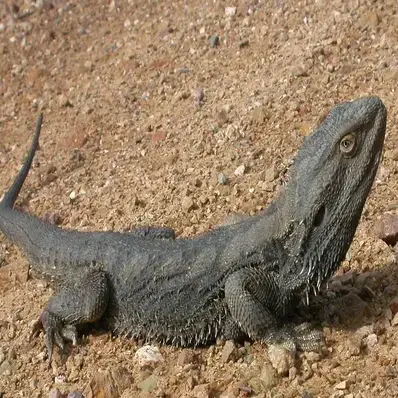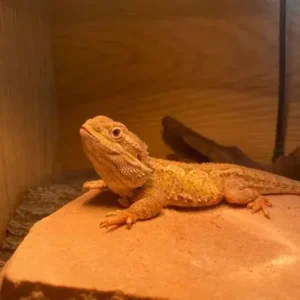History/Origin
The Eastern Bearded Dragon, scientifically known as Pogona barbata, has a rich history dating back centuries in its native habitat of Australia. Indigenous to the woodlands and deserts of eastern Australia, these reptiles have long been an integral part of the region’s ecosystem and indigenous cultures.
European settlers first documented Eastern Bearded Dragons Pogona barbata in the late 18th century, contributing to the scientific understanding of the species. Over time, they have become increasingly popular as pets due to their manageable care requirements.
Today, they are widely studied for their ecological role and admired for their distinctive features, making them an iconic symbol of Australian wildlife.
Personality
Species of bearded dragons are known for their calm and docile nature. They can become quite tame with regular handling, making them popular pets among reptile enthusiasts. They easily bond with owners through regular handling, displaying intelligence and adaptability.
Despite a stoic appearance, they show affection and recognition, responding to familiar voices and gestures. Their subtle behaviors, like exploring and basking, contribute to their charm, making them an appealing choice for reptile fanatics seeking an interactive and low-maintenance companion.
Head bobbing is a behavior commonly observed in both males and females. It involves the repeated, rhythmic movement of the head, usually performed in a vertical motion. Head bobbing can serve various purposes, including communication, territorial displays, and courtship rituals.
The arm wave in Eastern Bearded Dragons is a submissive behavior where they gently raise one front limb and move it in a waving motion. This gesture is a communication signal, expressing submission to avoid conflict with other dragons or predators.
Physical Appearance
- Size: Eastern Bearded Dragons typically range from 16 to 24 inches in length.
- Color: They exhibit various shades of brown, tan, and gray, often with hints of red or yellow, blending well with their natural surroundings.
Gender Differences
Male Eastern Bearded Dragons display distinct physical traits compared to females. As they mature, males typically develop larger heads and bodies, appearing more robust and muscular.
One notable feature unique to males is the prominent “beard” beneath their chin, which is absent in females. This beard, made of specialized scales, can change color and inflate during mating displays and territorial confrontations. It serves as a visual indicator of dominance and reproductive prowess.
In contrast, female Eastern Bearded Dragons lack this beard and generally have smaller bodies. These gender disparities are crucial in social interactions and reproductive behaviors. Female dragons lay clutches of up to 30 eggs after mating, while males may exhibit submissive behaviors by flattening their bodies or opening their mouths. Additionally, male dragons can store sperm to fertilize eggs at a later time.
Feed/Nutrition
Let’s take a closer look at the Eastern Bearded Dragons diet:
- Protein: Insects such as crickets and mealworms supply essential protein for growth and muscle development.
- Vitamins and Minerals: Leafy greens, vegetables, and fruits offer a spectrum of vitamins (A, C, K) and minerals (calcium, phosphorus) vital for bone health, immune function, and overall well-being.
- Fiber: Leafy greens and vegetables provide dietary fiber, promoting digestive health and preventing constipation.
Feeding Schedule
Offer a variety of foods to Eastern Bearded Dragons daily, ensuring a balanced diet. Monitor their appetite and adjust portions accordingly to prevent obesity and nutrient deficiencies.
Additionally, provide fresh water daily and consider dusting insects with calcium powder to supplement their diet. Regularly review and update their diet to meet their evolving nutritional needs as they grow and mature.
Health
Eastern Bearded Dragons are susceptible to various health issues that require vigilant monitoring and prompt veterinary attention.
Understanding these common concerns is crucial for maintaining their well-being:
Metabolic Bone Disease (MBD)
- Causes: Insufficient calcium intake, improper UVB lighting, and phosphorus-rich diets can lead to MBD.
- Symptoms: Weakness, tremors, deformities, and fractures are indicative of MBD.
- Prevention: Providing calcium supplements, proper UVB lighting, and a balanced diet rich in calcium and low in phosphorus can prevent MBD.
Respiratory Infections
- Causes: Inadequate temperatures, poor ventilation, and stress can predispose Eastern Bearded Dragons to respiratory infections.
- Symptoms: Wheezing, nasal discharge, labored breathing, and lethargy are signs of respiratory infections.
- Treatment: Antibiotics and supportive care are necessary to treat respiratory infections.
Parasitic Infections
- Types: Parasites like coccidia and pinworms can infest Eastern Bearded Dragons.
- Symptoms: Diarrhea, weight loss, and lethargy may indicate parasitic infections.
- Treatment: Antiparasitic medications prescribed by a veterinarian are essential for treating parasitic infections.
CANV (Chrysosporium anamorph of Nannizziopsis vreisii)
- Symptoms: Skin lesions, shedding issues, and discolored scales are characteristic signs of CANV.
- Treatment: Antifungal medications and supportive care are necessary to manage CANV infections.
Infectious Stomatitis (Mouth Rot)
- Causes: Poor dental hygiene, injury, or bacterial infection can lead to stomatitis.
- Symptoms: Swollen gums, pus around the mouth, and reluctance to eat are indicators of mouth rot.
- Treatment: Antibiotics and oral hygiene measures are crucial for managing infectious stomatitis.
Other Health Concerns
- Salmonella: Handling reptiles, including Eastern Bearded Dragons, carries a risk of Salmonella transmission to humans. Proper hygiene practices are essential.
- Avascular Necrosis: Poor blood supply to bones can result in avascular necrosis, leading to bone degeneration and fractures.
- Tail Rot: Trauma, improper shedding, and bacterial infections can cause tail rot, necessitating amputation in severe cases.
- Abscesses: Wounds and infections can lead to abscess formation, requiring drainage and antibiotics.
- Dystocia: Difficulty laying eggs can occur in gravid females, requiring veterinary intervention to prevent complications.
Care and Grooming
Proper care and grooming are essential for maintaining the health and well-being of Eastern Bearded Dragons.
Here’s how to ensure they thrive in captivity:
- Provide a spacious terrarium or enclosure with ample space for climbing, basking, and exploring.
- Use full-spectrum UVB lighting to mimic natural sunlight, which is crucial for synthesizing vitamin D3 and preventing metabolic bone disease.
- Maintain a temperature gradient within the enclosure, with a basking spot around 95°F (35°C) and a cooler area around 75°F (24°C) during the day. Night temperatures can drop to 65-75°F (18-24°C).
- Choose a safe substrate such as reptile carpet, newspaper, or ceramic tiles to prevent ingestion and impaction risks.
- Perform regular spot cleaning of waste and uneaten food to maintain a clean environment.
- Conduct a thorough substrate change and enclosure cleaning every 4-6 weeks to prevent bacterial buildup and odors.
- Provide opportunities for natural shedding by offering rough surfaces and objects for rubbing, such as rocks and branches.
- Monitor shedding progress and provide a humid hide or moistened substrate to aid in the shedding process if necessary.
- Inspect your Eastern Bearded Dragon regularly for signs of retained shed, stuck shed, or injuries, and address any issues promptly.
Rescue Groups
Several reptile rescue groups and organizations specialize in rescuing and rehoming Eastern Bearded Dragons. These groups provide care, rehabilitation, and adoption services for dragons in need of new homes.
Here are a few such groups:
Eastern Bearded Dragon for Sale
Reputable breeders offer Eastern Bearded Dragons for sale, ensuring they are healthy, captive-bred specimens. Buyers should prioritize obtaining dragons from ethical sources to support responsible breeding practices.
Interesting Facts
- Eastern Bearded Dragons can flatten their bodies and change color to regulate body temperature and communicate.
- They have specialized heat-sensing organs called “parietal eyes” on the top of their heads.
- Eastern Bearded Dragons can inflate their throat to appear larger when threatened.
- Eastern Bearded Dragons have a third eye, known as the pineal gland, which helps regulate their circadian rhythm.
Best For
Eastern Bearded Dragons make excellent pets for reptile enthusiasts looking for a docile and interactive companion. They are also suitable for educational purposes and reptile enthusiasts seeking a captivating species to observe and care for.
Top Names
| Male Eastern Bearded Dragon Names | Female Eastern Bearded Dragon Names |
| Spike | Ember |
| Rex | Luna |
| Draco | Willow |
| Rocky | Daisy |
| Thor | Ruby |










